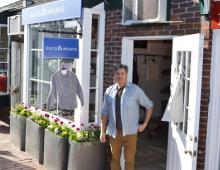960926 Recorded Deeds
960926 Recorded Deeds
AMAGANSETT
N.P. Funding II L.P. to Annabel Means and William Taussig, Montauk Highway, $192,500.
Borghi to John and Mark Kraus, Edwards Close, $885,000.
BRIDGEHAMPTON
Second Narrow Lane Corp. to Jeffrey and Jacqueline Chernov, Narrow Lane, $452,500.
Siwicki to Robert Savoia, Montauk Highway, $200,000.
Hildreth to George Dandridge and Marcos Tychbrojcher, Halsey Lane, $295,000.
Ganna Realty Corp. to Anne Hearst, Butter Lane, $485,000.
Walsh to Koral Dev. L.L.C., Scuttlehole Road $150,000.
EAST HAMPTON
Palmer to Nan Dillon, Osborne Lane, $215,000.
Bergsma to Lawrence Rich and Seymour Levy, Chestnut Way, $162,000.
Munson to Jeffrey Rosen and Richard Mervis, Mill Hill Lane, $430,000.
Malcomson to Thomas Dwyer, Morrell Boulevard, $203,000.
MONTAUK
Haft to Philip and Melanie Arfman, Otis Road, $178,000.
NORTHWEST
Esposito to Bruce Karp and Stephen Goldstone, High Point Road, $225,000.
Cipriano to Bruce and Phyllis Jaeger, Cobblers Court, $446,000.
NOYAC
Grillo to William Pratt and Diane Malanowski, Harbor Watch Court, $292,000.
SAG HARBOR
Daszewski estate to Kenneth and Wendy Bichel, Bayview Drive, $180,000.
Whitehead to Vincent and Ann Moore, Terry Drive, $160,500.
SAGAPONACK
Mumford to Robert Hurst, Bridge Lane (34.7 acres, vacant), $5,000,000.
North to David and Karen Schoenthal, Parsonage Lane, $900,000.
Sarlin to Emily Youssouf, Surfside Drive, $645,000.
Jones (trustee) to Mary Vassel, Sagg Road, $1,037,500.
SPRINGS
Cataletto estate to Edward Herbst and Barbara Close, King's Point Road, $260,000.
Lucchese to Albert and Natasha Dombrowski, Bay Inlet Road, $300,000.
WATER MILL
Foster to C. Paul and Marciana Verba, Hayground Road, $270,000.
Conrad to Kenneth and Ann Bialkin, Bay Lane, $2,225,000.
Ellenhorn to Howard Smiley, Seven Pond-Towd Road, $355,000.
Data provided by Long Island Profiles Publishing Co. Inc. of Babylon.


